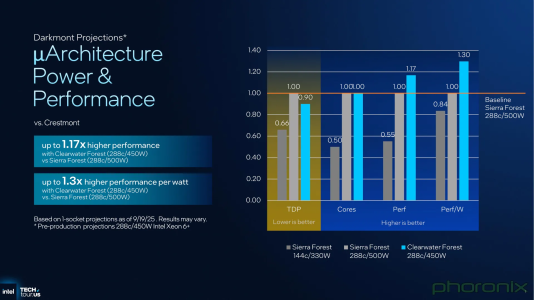George Cozma: Cool. So sort of talking about Cougar Cove, a key change made in Lion Cove was the lack of SMT. SMT in Lunar Lake and Arrow Lake is no longer there. Why wasn’t it -- could you have re-added it to Cougar Cove if you had wished? And why haven’t you added it back? Like what would be the reason why you wouldn’t?
Stephen Robinson: Yeah. So let’s talk about client first, right, where this is where we’ve shipped products without SMT. When you have hybrid compute, SMT isn’t necessarily as valuable, right? So when you schedule something, you know, if you want performance, you schedule it on a P core. And then you schedule it on an E core. And then, once you’ve exhausted those, then you would come back and schedule a thread.
So in Alder Lake, Raptor Lake, that’s kind of how it works. So those are the threads on top of the dessert, right? In Lion Cove, in Lunar Lake and Arrow Lake, you know, we removed threads. We didn’t have threads implemented. Let me say it that way. And so that gave us -- we didn’t lose a lot in client because of hybrid and the core count. But we gained a bit in our design execution, so a little bit lower power because you don’t have the transistors and the logic to support SMT. A little bit smaller area because -- same reason. And it’s a little bit easier to achieve your frequency target. Because, you know, the old joke that SMT is a bit in the mux [multiplexer], right? So there’s truth to that. There’s a mux somewhere. And that causes delay. So now you’ve kind of got something that’s maybe a little bit easier and less expensive and maybe can go a little bit faster.
So when you’re doing Cougar Cove, you just take those basic premises and say, yeah, this is what I’m going to do for the next gen as well.
George Cozma: And so on server, I know that there have been some data points that suggest that SMT does help. So what is sort of your opinion there?
Stephen Robinson: Yeah. So server is a little bit different than client. You know, people have talked about doing hybrid compute in servers. But nobody does it. And the simple explanation is if you want to be hybrid in servers, you do it at the rack-level, not inside an SOC. Why would I want asymmetry inside my SOC when I can have asymmetry, you know, a 200 core server, another 200 core server, and I’ve got a bunch of those. So you have the choice. You know, Amazon and others, they have different instances that you can go and you can get. So what’s the value of different instances within one?
So first, there’s no hybrid in servers today in general. The second thing is, you know, kind of the story I told about you’d schedule on P cores and E cores and come back with threads. Well, if you don’t have the E cores, then you’re going to go on threads. Server workloads and gaming workloads and others, right, they miss a lot. They can have long latency. And so when you miss and you have long latency, you’ve got available hardware. So in the server area, threads, there are more workloads that like it. You know, take a networking workload. Those usually like threads because they’re moving a lot of data around and they’re exposing those latencies. So the server workloads are a bit different. And without hybrid, then SMT has more value.




